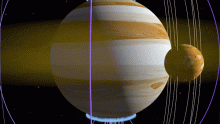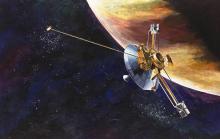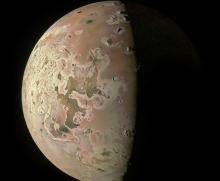Listen to today's episode of StarDate on the web the same day it airs in high-quality streaming audio without any extra ads or announcements. Choose a $8 one-month pass, or listen every day for a year for just $30.
You are here
Moon and Jupiter
In most ways, Jupiter is the most impressive planet in the solar system. It’s heavier than all the other planets combined. It has by far the strongest magnetic field, and the deadliest radiation belts. And it keeps jockeying with Saturn for the leadership in the number of moons.
One category where Jupiter is clearly outranked is rings. It has four main rings, but they’re puny compared to the rings of Saturn. Although their span is greater than the distance between Earth and the Moon, the rings are so faint that they weren’t discovered until 1979, when the Voyager 1 spacecraft flew past them.
The innermost ring is actually more like a doughnut — it’s thousands of miles thick. It begins not far above Jupiter’s clouds. Next out is the main ring, which contains most of the material in the ring system. And outside that is a pair of gossamer rings — rings that are so thinly spread that they’re especially hard to see.
The rings consist of dust grains and larger bits of rock and ice. That material quickly spirals into Jupiter. But the rings are kept supplied by collisions between space rocks and some of Jupiter’s moons. The impacts blast fresh material into orbit around Jupiter — keeping its rings from vanishing entirely.
Jupiter is in great view tonight. It looks like a brilliant star close to the Moon. They stay close as they arc high across the sky during the night. But Jupiter’s rings are too faint to see.
Script by Damond Benningfield






